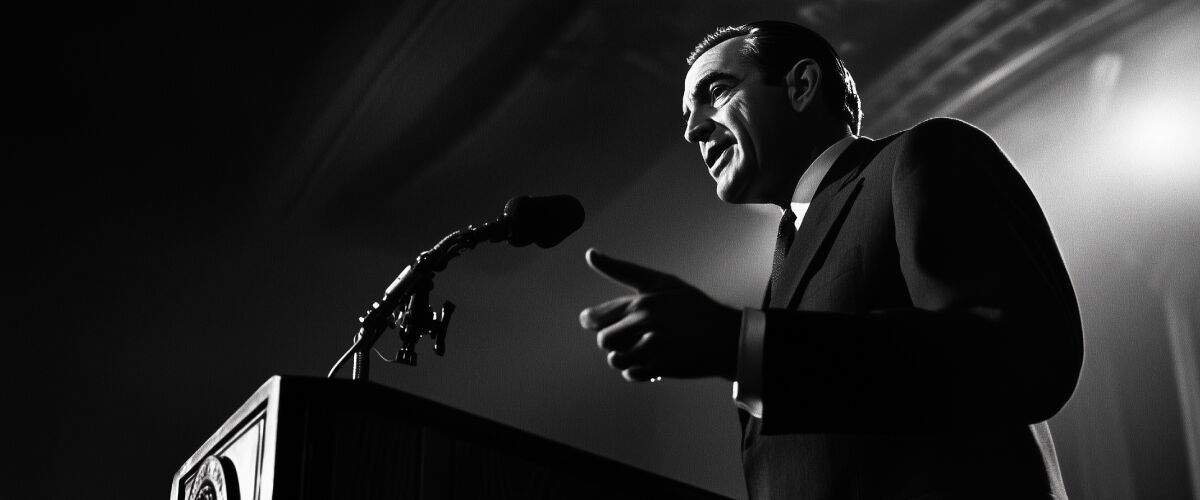Nixon’s Surprising Shift to Keynesian Economics
In 1971, President Richard Nixon supposedly told an ABC News reporter that he was “now a Keynesian in economics.” This statement was an acknowledgment that he agreed with the ideas put forward by British economist John Maynard Keynes. In his 1936 book The General Theory of Employment, Interest, and Money, Keynes recommended higher government spending and tax cuts to stimulate demand, aiming to pull the global economy out of the Great Depression. Keynes believed that business cycles—periods of economic expansion followed by recessions—were an inevitable consequence of capitalism. He argued that deficit spending during economic downturns was essential for economic recovery.
Nixon’s endorsement of Keynesian economics was shocking to many. At the time, he was widely viewed as endorsing the views of free-market economists who believed governments should not intervene in business cycles. To them, Keynesian economics seemed dangerously close to socialism, or even communism, due to its advocacy for active government involvement in the economy.
The End of the Gold Standard
A few months after Richard Nixon’s Keynesian remark, he ordered Treasury Secretary Connally to end the ability of foreign central banks to exchange US dollars for gold. This marked the end of the gold standard, a monetary system where currency value was directly linked to gold. Keynes would likely have approved of Nixon’s actions because he considered the gold standard to be a “barbarous relic.” Keynes believed the gold standard hampered governments’ ability to borrow money and should therefore be abolished to allow more flexible economic policies.
Free Wealth Protection Insights
Enter your email below to receive our weekly briefings on better ways to preserve your wealth, legally reduce your tax bill, and better protect what you’ve worked hard to build.
The Nestmann Group does not sell, rent or otherwise share your private details with third parties. Learn more about our privacy policy here.
PLEASE NOTE: This e-series will be delivered to you via email. You should receive your first message minutes after joining us. By signing up for this course, you’ll also start to receive our popular weekly publication, Nestmann’s Notes. If you don’t want to receive that, simply email or click the unsubscribe link found in every message.
The Evolution of Keynesian Policies
While Keynes advocated for deficit spending during economic downturns, he did not support unlimited deficit spending. According to Keynesian economics, there should also be a commitment to fiscal responsibility. In times of economic prosperity, Keynes believed that governments should accumulate surpluses. These surpluses could then be used to fund interventionist measures during future recessions. However, today’s economic policies have diverged significantly from these original principles. Many governments now feel no obligation to balance budgets or accumulate surpluses, even when the economy is booming.
For example, the US economy experienced substantial growth from mid-2009 until early 2020, when the COVID-19 recession hit. During this period of economic boom, the national debt more than doubled. It increased from $10.6 trillion in 2009 to $22.8 trillion by the end of the 2019 fiscal year.
The Impact of the COVID-19 Pandemic on Deficit Spending
Then came COVID-19, which had a significant impact on the economy. By the end of the 2020 fiscal year, the national debt had climbed by another $4.2 trillion, reaching $26.9 trillion. This increase was primarily due to the government’s response to the pandemic. The borrowing received bipartisan support, as Congress passed the $2.2 trillion COVID relief package on March 31, 2020. It was approved through a near-unanimous voice vote in the House and a 96-0 vote in the Senate.
While we may have all been Keynesians in 1971 when Nixon ended the gold standard, we’re hyper-Keynesians now. With federal debt this high, we are truly in uncharted territory. Yet, remarkably, mainstream economists aren’t that concerned about it. A typical example is Nobel laureate Esther Duflo, who says, “That is not something that the general public should be worried about for the time being at all.”
The Current Debt Situation: Should We Be Worried?
It’s understandable why some economists are not worried. Skyrocketing debt hasn’t led to the disastrous outcomes economic conservatives feared—at least so far. For instance, the US has not experienced runaway inflation. However, some argue that inflation is significantly higher than official statistics indicate. This situation has also been observed in Japan, where the debt-to-GDP ratio now exceeds 250%—the highest in the world.
However, the consequences of massive debt accumulation are becoming apparent in other ways. The debt rampage undertaken by the United States, Japan, and other countries has seriously eroded the value of their respective currencies relative to gold. Since the gold standard ended in 1971, the values of the US dollar and British pound have fallen more than 98% relative to gold. The Japanese yen fell a bit less, at 93%. Even the mighty Swiss franc has lost more than 90% of its value relative to gold since 1971.
Financial Repression and the Future of Currency Values
Another consequence of the world’s love affair with soaring debt is “financial repression” by central banks. This repression is characterized by zero or even negative interest rates. Even if inflation returns, central banks may find it impossible to raise interest rates, as doing so could lead to further erosion of currency values.
A free lunch is a wonderful thing for everyone if no one ever has to pick up the tab. If you agree with mainstream economists that deficits don’t matter, hold on to your dollars at zero interest rates and wait for the post-COVID economic boom. But if you don’t agree, you might consider buying gold.
Need Help?
Since 1984, we’ve helped more than 15,000 customers and clients protect their wealth using proven, low-risk domestic and offshore planning. To see if our planning is right for you, please book in an introductory consultation with one of our Associates. You can do that here.













